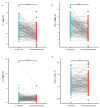In-hospital and mid-term follow-up of low-density lipoprotein cholesterol and target-goal attainment among patients with acute cerebral infarction: a retrospective study
- PMID: 38419043
- PMCID: PMC10900700
- DOI: 10.1186/s12944-024-02044-w
In-hospital and mid-term follow-up of low-density lipoprotein cholesterol and target-goal attainment among patients with acute cerebral infarction: a retrospective study
Abstract
Objective: To investigate the baseline and six-month follow-up data of the main lipid indices as well as low-density lipoprotein cholesterol (LDL-C) target goal attainment in accordance with the current guidelines among patients with acute cerebral infarction (ACI).
Methods: One thousand ninety-nine patients were consecutively enrolled from January 2021 to December 2022 and divided into ACI, old cerebral infarction (OCI), and control groups. General data [sex, age, body mass index (BMI), medications, smoking status, disease history, etc.], baseline data, and six-month follow-up main laboratory data were collected and analyzed. ACI patients were grouped into dyslipidemia and normal groups according to the lipid management guidelines of the European, American, and Chinese populations. Statistical methods were used to screen for possible predictors of dyslipidemia.
Results: Patients with ACI or OCI had higher total cholesterol (TC) and LDL-C levels than did the control group (all P < 0.05). According to European (94.7%, 89.0% and 13.4%, P < 0.01), American (94.7% vs. 67.7% vs. 45.9%, P < 0.001) and Chinese (85.1% vs. 59.1% vs. 18.6%, P < 0.001) standards, the proportion of dyslipidemia in the ACI group was greater than that in the OCI and control groups. According to European and American standards, increases in BMI and the estimated glomerular filtration rate (eGFR) are predictors of dyslipidemia in ACI patients. According to Chinese standards, increases in BMI, glycated hemoglobin (HbA1c) levels, and eGFRs are independent predictors of dyslipidemia in ACI patients. The 6-month follow-up of the main lipid levels revealed that among the ACI group, TC, LDL-C and triglyceride(TG) levels (4.86 vs. 3.79, P < 0.001; 2.98 vs. 2.01, P < 0.001; 1.46 vs. 1.20, P < 0.001) and the proportion of dyslipidemia decreased significantly in accordance with European/American and Chinese standards (86.8% vs. 64.6%, P = 0.015; 97.2% vs. 84.7%, P = 0.012).
Conclusion: These results revealed that lipid management is still not optimal for patients with ACI. More attention should be given to ACI patients with elevated BMI, eGFR, and HbA1c values, which could lead to more individualized lipid management. Although the main lipid levels decreased significantly 6 months after discharge with lipid-lowering therapy, there is still a long way to go to enable more ACI patients to meet the guideline-recommended LDL-C target goal.
Keywords: Atherosclerotic cardiovascular disease; Dyslipidemia; Low-density lipoprotein cholesterol; Stroke.
© 2024. The Author(s).
Conflict of interest statement
The authors declare no competing interests.
Figures


Similar articles
-
[Status of cholesterol goal attainment for the primary and secondary prevention of atherosclerotic cardiovascular disease in dyslipidemia patients receiving lipid-lowering therapy: DYSIS-China subgroup analysis].Zhonghua Xin Xue Guan Bing Za Zhi. 2016 Aug 24;44(8):665-70. doi: 10.3760/cma.j.issn.0253-3758.2016.08.006. Zhonghua Xin Xue Guan Bing Za Zhi. 2016. PMID: 27545124 Chinese.
-
Lipid levels and use of lipid-lowering drugs for patients in pharmacist-managed lipid clinics versus usual care in 2 VA Medical Centers.J Manag Care Pharm. 2005 Nov-Dec;11(9):763-71. doi: 10.18553/jmcp.2005.11.9.763. J Manag Care Pharm. 2005. PMID: 16300420 Free PMC article.
-
Results of retrospective chart review to determine improvement in lipid goal attainment in patients treated by high-volume prescribers of lipid-modifying drugs.J Manag Care Pharm. 2006 Nov-Dec;12(9):745-51. doi: 10.18553/jmcp.2006.12.9.745. J Manag Care Pharm. 2006. PMID: 17249907 Free PMC article.
-
Pitavastatin: novel effects on lipid parameters.Atheroscler Suppl. 2011 Nov;12(3):277-84. doi: 10.1016/S1567-5688(11)70887-X. Atheroscler Suppl. 2011. PMID: 22152282 Review.
-
Dyslipidemia: A Narrative Review on Pharmacotherapy.Pharmaceuticals (Basel). 2024 Feb 23;17(3):289. doi: 10.3390/ph17030289. Pharmaceuticals (Basel). 2024. PMID: 38543075 Free PMC article. Review.
Cited by
-
Percheron syndrome with memory impairment as chief manifestation: A case report.World J Clin Cases. 2025 May 6;13(13):98937. doi: 10.12998/wjcc.v13.i13.98937. World J Clin Cases. 2025. PMID: 40330285 Free PMC article.
References
-
- Liu L, Chen W, Zhou H, Chinese Stroke Association Stroke Council Guideline Writing Committee et al. Chinese Stroke Association guidelines for clinical management of cerebrovascular disorders: executive summary and 2019 update of clinical management of ischemic cerebrovascular diseases. Stroke Vasc Neurol. 2020;5(2):159–76. doi: 10.1136/svn-2020-000378. - DOI - PMC - PubMed
-
- Chinese Medical Association, Chinese Medical Journals Publishing House, Chinese Society of General Practice, et al. Guideline for primary care of dyslipidemias: practice version(2019). Chin J Gen Pract. 2019;18(5):417–421.
-
- Grundy SM, Stone NJ, Bailey AL. AHA/ACC/AACVPR/AAPA/ABC/ACPM/ADA/AGS/APhA/ASPC/NLA/PCNA guideline on the management of blood cholesterol. A report of the american college of cardiology/american heart association task force on clinical practice guidelines. Circulation. 2019;139(25):e1082–143. - PMC - PubMed
MeSH terms
Substances
Grants and funding
LinkOut - more resources
Full Text Sources
Research Materials
Miscellaneous

